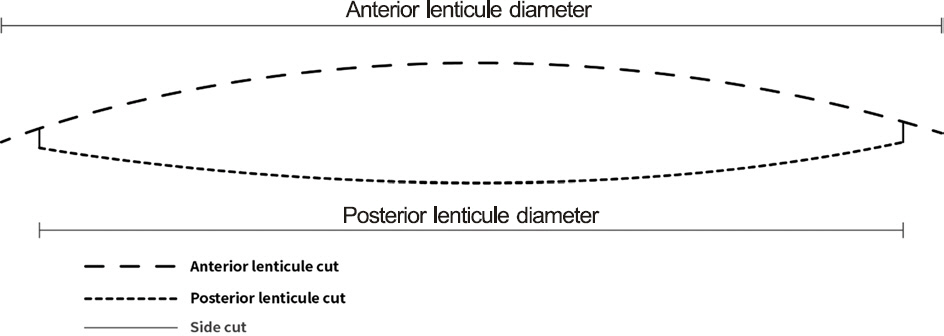J Korean Ophthalmol Soc.
2015 Aug;56(8):1274-1277. 10.3341/jkos.2015.56.8.1274.
A Case of Suction Loss During SMILE and a Switch to LASIK
- Affiliations
-
- 1Onnuri Smile Eye Clinic, Seoul, Korea. ytchungc@daum.net
- KMID: 2215082
- DOI: http://doi.org/10.3341/jkos.2015.56.8.1274
Abstract
- PURPOSE
To report a case of suction loss during small incision lenticule extraction (SMILE) and a good visual outcome after switching to femtosecond laser-assisted in-situ keratomileusis (LASIK).
CASE SUMMARY
A 20-year-old female was admitted to receive refractive surgery. During SMILE in the left eye, suction loss occurred at 65% of posterior cut completion. We switched to LASIK and SMILE was performed in the right eye as planned. The uncorrected distance visual acuity was 1.2 with a manifest refraction of +0.25 Dsph with 0 Dcyl. The patient had no complications at 3 months postoperatively.
CONCLUSIONS
Suction loss during SMILE is a rare complication. Good visual outcome was achieved by switching to LASIK.
MeSH Terms
Figure
Cited by 1 articles
-
Clinical Outcome of Small Incision Lenticule Extraction including Visual Quality Analysis
Gi Sung Son, Su Chan Lee, Tae Hyung Lim
J Korean Ophthalmol Soc. 2016;57(4):562-567. doi: 10.3341/jkos.2016.57.4.562.
Reference
-
References
1. Shah R, Shah S, Sengupta S. Results of small incision lenticule ex-traction: all-in-one femtosecond laser refractive surgery. J Cataract Refract Surg. 2011; 37:127–37.
Article2. Gao S, Li S, Liu L. . Early changes in ocular surface and tear in-flammatory mediators after small-incision lenticule extraction and femtosecond laser-assisted laser in situ keratomileusis. PLoS One. 2014; 9:e107370.
Article3. Kim JR, Hwang HB, Mun SJ. . Efficacy, predictability, and safety of small incision lenticule extraction: 6-months prospective cohort study. BMC Ophthalmol. 2014; 14:117.
Article4. Lin F, Xu Y, Yang Y. Comparison of the visual results after SMILE and femtosecond laser-assisted LASIK for myopia. J Refract Surg. 2014; 30:248–54.
Article5. Ganesh S, Gupta R. Comparison of visual and refractive outcomes following femtosecond laser- assisted lasik with smile in patients with myopia or myopic astigmatism. J Refract Surg. 2014; 30:590–6.6. Sekundo W, Kunert KS, Blum M. Small incision corneal refractive surgery using the small incision lenticule extraction (SMILE) pro-cedure for the correction of myopia and myopic astigmatism: re-sults of a 6 month prospective study. Br J Ophthalmol. 2011; 95:335–9.
Article7. Ivarsen A, Asp S, Hjortdal J. Safety and complications of more than 1500 small-incision lenticule extraction procedures. Ophthalmology. 2014; 121:822–8.8. Wong CW, Chan C, Tan D, Mehta JS. Incidence and management of suction loss in refractive lenticule extraction. J Cataract Refract Surg. 2014; 40:2002–10.
Article9. Ang M, Chaurasia SS, Angunawela RI. . Femtosecond lentic-ule extraction (FLEx): clinical results, interface evaluation, andintraocular pressure variation. Invest Ophthalmol Vis Sci. 2012; 53:1414–21.10. Arevalo JF, Rodriguez FJ, Rosales-Meneses JL. . Vitreoretinal surgery for macular hole after laser assisted in situ keratomileusis for the correction of myopia. Br J Ophthalmol. 2005; 89:1423–6.
Article
- Full Text Links
- Actions
-
Cited
- CITED
-
- Close
- Share
- Similar articles
-
- Factors Affecting the Thickness of Suction Ring in LASIK
- Changes in Intraocular Pressure and Factors that Influence such Changes after FS-LASIK and SMILE
- Comparison of Perioperative Contrast Sensitivity between Laser in situ Keratomileusis and Small-incision Lenticule Extraction
- Dry Eye Syndrome after Refractive Surgery: Comparative Outcomes of SMILE and LASIK
- A Case of Acute Central Stromal Melting after LASIK



